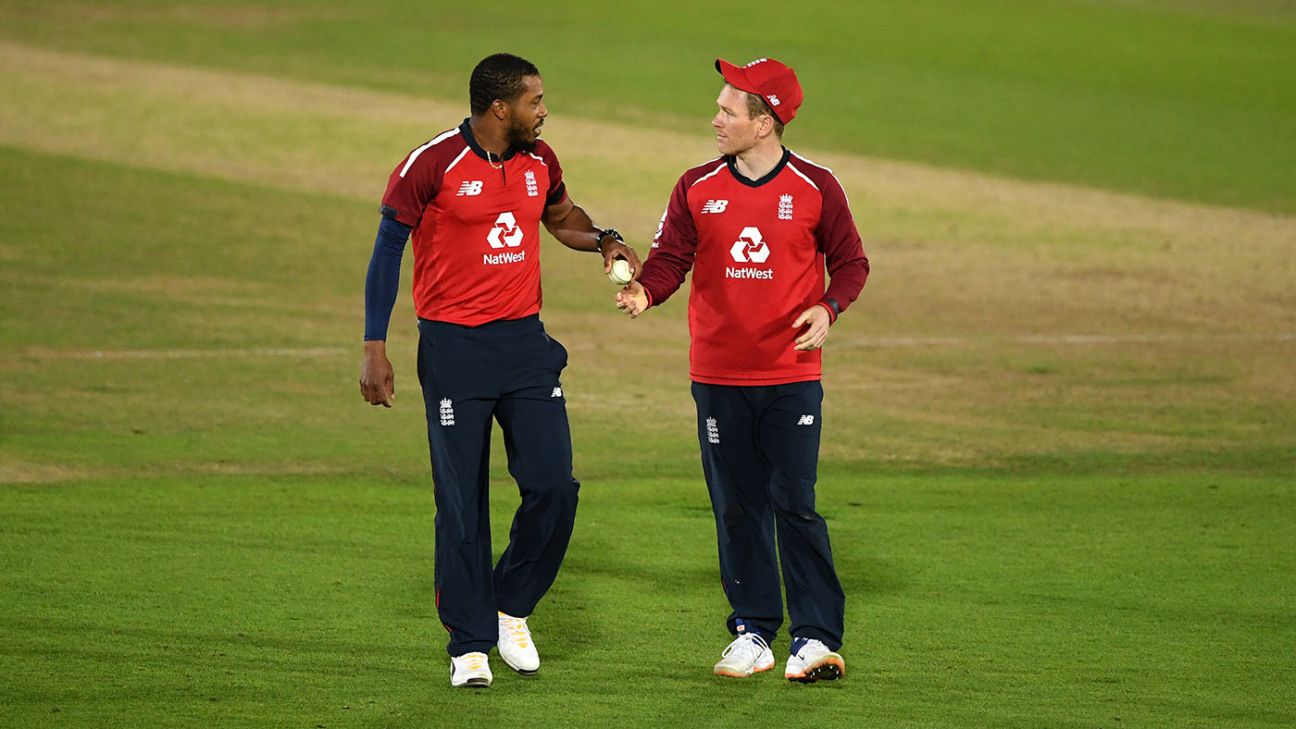
Death-bowling plans in T20 cricket tend to be straightforward: bowl yorkers to stop batsmen getting any elevation, and vary your pace to mess with their timing. Execution is difficult, but the formula is generally simple.
But England had different ideas on Friday night in Southampton. Rather than bowling at Australia's toes, they continued to bang the ball in on a length. In the last five overs, their four seamers bowled a single yorker between them, with 24 out of 30 balls pitching on a length or shorter as Marcus Stoinis and Ashton Agar struggled to time the ball off the pitch.
Eoin Morgan hailed his bowlers' adaptability after the game, suggesting that "two years ago, we would have gone to bowling yorkers or slower balls which would have brought Australia back into the game" and expressing his delight that England "stuck to our guns" after working out that length balls were "hardest to hit" on that surface.
Chris Jordan exemplified that plan, continuing to hit the pitch as he conceded only four runs from the 19th over, leaving 15 to win off the final six balls. "In the last over I didn't actually bowl one yorker," he said. "Because we started - from when Jof [Jofra Archer] and Woody [Mark Wood] came on - to really use the pitch.
"We banged the pitch hard, nice and straight, and that's what really got us back into the game. We just sort of stuck with it, and executed that along the way. It's a matter of working with the conditions you have along the way."
While England's adaptability at the death worked brilliantly, their comeback helped mask another concerning display with the ball in the Powerplay, as Australia raced to 55 for 0 off the first six overs. Morgan admitted that new-ball bowling was "an area that we're trying to improve on" before the series, and England have now taken just three wickets in 36 Powerplay overs this calendar year while conceding 9.83 runs per over.
"When Woody and Jof came on in that middle period, that's when it started to change for us. They started really coming hard at the Aussie batsmen and shifted momentum back in our favour" Chris Jordan said the game was won by England's two quickest bowlers
In that light, it was a surprise that Sam Curran was left out of the side on Friday night, having been included in the squad ahead of David Willey as the new-ball swing bowler. Jordan himself has been wicketless in the Powerplay since November 8 last year when he dismissed Tim Seifert in Napier, and admitted that he thought England should have bowled fuller lengths early on.
"In the Pakistan series, I thought we went to our variations in the Powerplay a little too early [in the second T20I], and in the game after that we rectified if and tried to hit the pitch nice and hard and hit the stumps for a bit longer," he said.
"Again, last night, maybe we can look at how many balls are hitting the stumps and the pads, because you are looking for wickets in that Powerplay. Maybe we were a little bit short and we got tucked away on the leg side and the off side, because they are two very good players of back of a length. Maybe that's an area for us to look at.
"But the bowlers' performance on the whole was spot on. When Woody and Jof came on in that middle period, that's when it started to change for us. They started really coming hard at the Aussie batsmen and shifted momentum back in our favour.
"Over the last few years especially, a lot of the talk has been about the batting lineup and how phenomenal it is. But it was nice last night that the bowlers in a sense bailed the batters out. TC's [Tom Curran's] final over was brilliant: he held his nerve and stayed as calm as possible in the situation, and executed the plans which was the most important thing."
ALSO READ: Australia set to persist with Stoinis in middle order
Jordan won his 50th T20I cap on Friday night, and could leapfrog Stuart Broad to become England's all-time leading wicket-taker in the format with a strong finish to the series. If he manages to do so, his feat will be made all the more impressive by the fact that he has played through injury for most of his England career, going under the knife during lockdown after managing it since 2015.
He experienced elbow pain that year, and began to notice some wastage in his right biceps, which continued to diminish with the stress of fast bowling, creating various knock-on problems. He said that the surgery, which decompressed a nerve in the neck area that had become trapped, had "definitely not" left him at 100% fitness or put the issue to bed, but instead represented "the first step" on the road to recovery.
"In an ideal world, you'd have liked to have had [the surgery] at the beginning of the lockdown," Jordan said. "But for obvious reasons, elective surgery was halted, so I had to wait until a lot of the restrictions were eased.
"It was a decision that took a lot of thought and consulting with the various doctors I trust and the ECB medical team and staff have been brilliant and supportive of me in that decision and I'm grateful for that."















 Phone: (800) 737. 6040
Phone: (800) 737. 6040 Fax: (800) 825 5558
Fax: (800) 825 5558 Website:
Website:  Email:
Email: 






